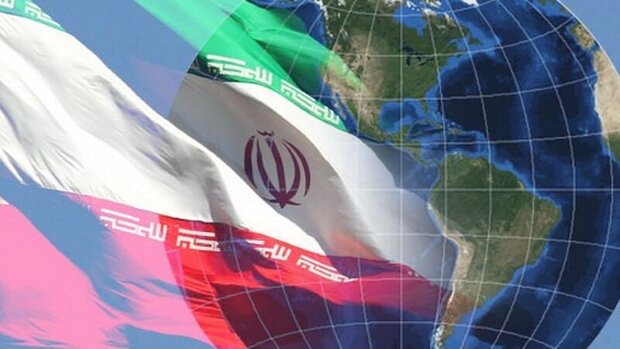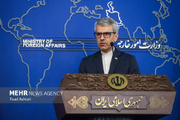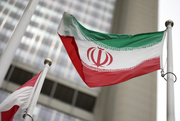As part of its transport policy, recent transport developments advanced by Iran's Ministry of Transport and Urban Development in relation with 15 neighboring countries are outlined in the following sections and categorized geographically into northern, eastern, southern, and western neighbors.
KTI Railway Corridor launched
The Presidents of Iran and Kazakhstan have officially launched a rail transit link that will boost freight transport between Asia and Europe amid turbulent times in the region.
Kazakhstan-Turkmenistan-Iran (KTI) Railway Corridor is being operated in June 2022 and the first freight train arrived in Tehran on June 19.
Via this corridor, part of the cargo passing through the China-Russia-Europe railway corridor will be transported through Iran along the China-Kazakhstan-Iran-Europe railway corridor.
Back in November 2021, Iran, Kazakhstan, and Turkmenistan signed a tripartite MoU on railroad cooperation. The MoU was negotiated and agreed upon on the sidelines of the Economic Cooperation Organization (ECO) summit.
Increased rail transit through Iran's gateway to Central Asia
During the 16th Iran-Turkmenistan Joint Economic, Scientific, Commercial, Technical, and Cultural Commission held in October 2021 in Tehran, Iran's transport minister and Turkmen foreign minister who chaired the commission signed a comprehensive MoU which included rail transit and road freight.
Afterwards, in June 2022, the high-ranking transport officials of Iran and Turkmenistan met in Tehran to renew mutual transport ties to ease transit along the corridors in the region.
In the last few months, the two countries have taken practical steps to renew their relations which has led to a 50 percent increase in transit.
Following the negotiations, rail transit through Sarakhs Border Terminal has increased to 200 wagons per day which have the capacity for increase by 400 wagons. Similarly, Incheh Borun Border Terminal has the capacity to transit 50 to 200 wagons per day.
The cooperation of Iran and Turkmenistan will ease transit along East-West and North-South transport corridors, particularly through the new alternative route of China-Kazakhstan-Iran-Europe instead of the previous route which passed through Russia.
Access to SCO countries eased
In November 2021 during the visit of Iran Minister of Transport and Urban Development, Rostam Ghasemi, with Kyrgyzstan Minister of Economy and Commerce, Daniyar Amangeldiev, Iran and Kyrgyzstan considered the possibilities of rail transit from Bandar Abbas to Kyrgyzstan considering the existing agreement with Turkmenistan.
With regard to the recent membership of Iran in the Shanghai Cooperation Organization (SCO), Iran can use Kyrgyzstan as a Corridor to the countries in the SCO region and similarly Kyrgyzstan can access eastern and southeastern countries via Iran.
Iran and Tajikistan's renewed ties activate KTAI Transport Corridor
Iran and Tajikistan have resumed their relations following the visits of the two countries' Presidents in September 2021 during the SCO summit in Dushanbe and also in May 2022 in Tehran. Subsequently, in June 2022, the Tajik delegation to Iran discussed with Iran's transport officials the proposals for promoting bilateral and multilateral transport ties via different transport modes.
In close cooperation with other involving countries including Afghanistan and Turkmenistan, the facilitation of transit along the Kyrgyzstan-Tajikistan-Afghanistan-Iran (KTAI) transport corridor, as well as ECO corridors, are on priority in the bilateral relations.
In doing so, the proposal for holding a transport committee would be a practical solution to ease the access of landlocked Tajikistan to the high seas through the Chabahar Port (to the south) and Amirabad Port (to the north). Similarly, Tajikistan can ease transit through Iran to China.
Iran to provide Uzbekistan access to the high seas
Uzbekistan's willingness to invest in Chabahar Port had been the key linchpin of the two countries' collaboration.
This is particularly important for land-locked Uzbekistan to link to the high seas and India through the only ocean port of Iran and advance trilateral cooperation with Iran and India.
Chabahar-Zahedan Railroad, as the missing part of the eastern railway transport corridor within Iran, is attractive to investors from different countries. In this sense, Uzbekistan officials consider linking Chabahar Port to the rail network and also forming a logistic center for packing export/import goods at this Port.
The commercial turnover between Uzbekistan and India has considerably increased in the last year up to 251 million tons which is expected to increase fourfold.
Joint infrastructural project to facilitate trade and transit
Iran and Azerbaijan analyze the possibility of a road link between Nackchivan and Azerbaijan through Iran's territory that was previously agreed upon during the 15th Iran, Azerbaijan Joint Economic Committee in March 2022.
On January 25, the agreement for the construction of a road bridge over the Astarachay River at the border of the two countries was signed by Kheirollah Khademi, Iran's Deputy Minister of Transport, and Rahman Hummatov, Deputy Minister of Digital Development and Transport of the Republic of Azerbaijan. The construction of the bridge over the Astarachay River is expected to finish by the end of the year.
Also, in the bilateral talks, the Astara-Astara rail dock project has been on agenda.
Iran to have direct access to Yerevan
Iran and Armenia are participating in completing the southern part of the strategically important Tatev Road in the Sisian (southern Armenia) to Nurduz in Iran as an alternative route to Goris-Kapan Road which would bypass Azerbaijan territory.
Moreover, Iran expressed readiness to export technical and engineering services to Armenia by Iranian contractors and companies for completing the construction of the above-mentioned Corridor stretching from Nurduz to Yerevan with higher productivity.
Georgia key point along the Persian Gulf-Black Sea Corridor
In December 2021, Iran, Azerbaijan, and Georgia successfully transited a trial run road freight fleet from Iran (Bileh Savar border terminal in northwestern Ardabil Province in Azerbaijan) to the Black Sea region. In the trial run, the loading of exported goods was in Iran and the destination was Europe.
Linking the Persian Gulf to the Black Sea is among the key plank of connectivity programs attempted by Georgia, Azerbaijan and Iran due to the proximity to three important seas in the region.
Thus, Iran is seeking to initiate the 'Persian Gulf-Black Sea Corridor' strategic transport corridor alongside other existing corridors. The Corridor links the Indian Ocean and East Asia to Europe through the member countries of the agreement including Iran, Azerbaijan, Armenia, Georgia, Bulgaria, and Greece.
Above all, the multimodal Persian Gulf-Black Sea Corridor Agreement will diversify Iran's transport corridors for transit from East and Southeast Asia including China, India, and the Persian Gulf states to the Caucasus and Europe and secure Iran's interests economically and geopolitically.
Table 1. Iran's transport ties northwards
| The Northern Neighbors |
||
| Ties/agreements |
date |
|
| Turkmenistan |
Opening of Sarakhs and Incheh Borun Border |
June 2022 |
| Uzbekistan |
Possible investments in Chabahar Port |
January 2022 |
| Kazakhstan |
Launching KTI railway Corridor |
June 2022 |
| Kyrgyzstan |
Possibility of rail transit from Bandar Abbas to Kyrgyzstan |
November 2021 |
| Tajikistan |
Decision to form transport committee to ease transit and trade |
25 June 2022 |
| Azerbaijan |
|
May 2022 January 2022 |
| Armenia |
Construction of Tatev Road |
Since October 2021 |
| Georgia |
Joint initiation of the Persian Gulf-Black Sea Corridor |
February 2022 |
The ECO train along ITI Railway Corridor resumed operation
After almost two years of hiatus, Iran's trucks resumed transit from Mirjaveh Border to Pakistan's territory. Previously, during two years of the covid-19 pandemic, Iran's trucks were allowed to transit through the Mirjaveh border crossing just up to Taftan custom; however, from February 25 onwards Iranian trucks resumed transit directly to Pakistan's territory. Currently, more than 150 trucks transit through Mirjaveh Border to Pakistan per day.
Moreover, The Economic Cooperation Organization (ECO) freight train resumed its operation along the Islamabad-Tehran-Istanbul (ITI) Corridor and arrived in Iran in December 27, 2021, from Mirjaveh Border and then after transhipment entered Istanbul through the Razi Border crossing.
ECO train as the most effective mode of transport for freight transfer can play an important role in expanding export and commercial transactions between the member countries.
Istanbul–Tehran–Islamabad railway (ITI Train) is about 6500 km of which 1990 km is in Pakistan's territory, 2603 km in Iran’s territory, and 1950 km within Turkey’s territory.
Compared to the maritime routes, the travel time for freight transfer along this route is estimated to be less than half.
The operation of this corridor leads to increased regional connectivity and will boost economic activities in the region.
The Islamabad-Tehran-Istanbul railway project was inaugurated with the first freight train moving on 22 December 2021 during a ceremony attended by Iranian and Pakistani officials.
Iran's transport ties with Afghanistan important for the Eastern Corridor
Iran's transport cooperation with Afghanistan is within the framework of transit corridors, particularly the Kyrgyzstan-Tajikistan-Afghanistan-Iran (KTAI) transport corridor and different routes along the ECO corridor.
Moreover, during the visit of the CEO of Iran’s Technical and Soil Mechanics Laboratory (TSML) Company, Majid Kianpour, with Afghanistan’s delegations to Iran, Iran expressed willingness to offer services to Afghanistan including technical, engineering, and training services based on technical needs of Afghanistan.
Table 2. Iran's transport ties eastwards
| The Eastern Neighbors |
||
| Ties/agreements |
date |
|
| Pakistan |
|
Since 25 February 2022 December 2021 |
| Afghanistan |
|
January 2021 |
Shalamcheh-Basra Railroad marks a historical link
Iran and Iraq transport cooperation had been mainly in rail transport when Iran and Iraq top officials signed the agreement for Shalamcheh-Basra Railroad in December 2021.
The negotiations for a 32 km railroad between Iran and Iraq had been ongoing for the last 20 years; however, they had not come to a conclusion until recently.
Urmia-Serow Highway to facilitate Iran, Turkey road link
The rail link between Iran and Turkey is via ECO freight train along the Islamabad-Tehran-Istanbul (ITI) Corridor which successfully resumed its operation in December 2021.
The ECO meeting acknowledged the activation of the ITI Corridor and emphasized the removal of the impediments to the regularization of this Corridor during the 11th Economic Cooperation Organization (ECO) Ministerial Meeting on Transport hosted virtually by Turkey in February 2022. In the ECO meeting, the member states called for promoting ECO's intra-regional and inter-regional connectivity including the extension of the ITI Corridor to Europe and China.
For the road link, the construction of the Urmia-Serow Highway in the West Azerbaijan Province in Iran as part of the country's west road network plays an important role in developing economic transactions and freight and passenger transit between Iran and Turkey. The 51 km long highway is expected to be inaugurated this year in the next few weeks. Infrastructural investments in the Serow border terminal have also been considered for increased economic transactions.
Table 3. Iran's transport ties westwards
| The Western Neighbors |
||
| Ties/agreements |
date |
|
| Turkey |
|
February 2022 2022 |
| Iraq |
Agreement for Shalamcheh-Basra Railroad |
December 26, 2021 |
Iran, Qatar eye for maritime cooperation
Iran and Qatar strengthen their mutual ties during several official meetings and agreements.
Iran and Qatar transport ministers, Rostam Ghasemi and Jassim bin Saif Al Sulaiti, met both in Doha and Kish island to arrange for the FIFA World Cup 2022 to be held in Qatar from November 21 to December 18.
Iran's potential in Bushehr and Hormozgan Provinces, particularly Kish Island, can support Qatar in the World Cup 2022.
In this sense, four agreements were reached in Doha in February during the official visit of Iran's President to Qatar. Afterwards, in April, details of cooperation in six areas were signed in Kish.
The agreements include launching regular shipping lines between the ports of the two countries and a proposal for the construction of an undersea tunnel between Iran and Qatar.
The aforementioned project is a huge connectivity project that stretches from Deyr Port (in Bushehr) to Qatar and will link Qatar to the northern countries, Europe, the countries in the Caspian region, and Southwest Asia.
Iran, Oman initiate unprecedented maritime transport
In February, Iran and Oman signed an MoU during the 19th meeting of the Joint Economic Committee in order to promote economic ties and maritime trade through Chabahar Port. The MoU was reached in Muscat between Seyed Reza Fatemi Amin, Iran Minister of Industry, Mines, and Trade, and Qais bin Mohammed Al Yousef, Oman Minister of Commerce and Industry.
Within the framework of the MoU, the two sides emphasized promoting economic ties and maritime trade through Chabahar Port.
Moreover, in May 2022, during the visit of Iran's President with the Sultan of Oman, the two countries discussed maritime transport between Bandar Abbas Port in Iran and the Port of Al Suwaiq in Oman and establishing a passenger ship between Chabahar and Muscat.
Easing traffic of Islamic Republic of Iran Shipping Lines in the Ports of Salalah and Sohar in Oman is among other agendas for joint cooperation.
Oman is expected to join the trilateral Chabahar Agreement.
UAE-Iran-Turkey Corridor boosts regional trade
Trucks transit since late 2021 through ro-ro ferry from Sharjah to Bandar Abbas Port and then overland through Iran's multi-lane highways to the Turkish Mediterranean Sea port of Mersin marked the opening of a strategic corridor that reduces transit time from 21 to 6 days generally for the trip from the Arabian Peninsula to the Mediterranean.
Above all, this will facilitate Iran's integration into the region and its active role in the global trading system. This is also politically important as further economic integration will undermine the adverse effects of sanctions by the United States to keep Iran isolated.
Pakistan and Central Asian countries are also looking to the route through Iran for freight transfer.
Table 4. Iran's transport ties southwards
| The Southern Neighbors |
||
| Ties/agreements |
date |
|
| Qatar |
|
April 2022 |
| Oman |
|
May 2022 February 12 |
| UAE |
|
Late 2021 |
Iran-Russia cooperation to ease traffic along INSTC
Transit through the International North-South Transport Corridor (INSTC) following the official launch of the eastern section of the Corridor by the arrival of the first Russian rail freight transit to India through Iran marks the most important development in Iran, Russia transport ties.
The train left Russia from Chekhov on July 6 and headed to India's Nhava Sheva Port. It entered Iran on 12 July 2022 through Sarakhs Border after travelling 3800 kilometers through Kazakhstan and Turkmenistan. The train carrying 39 containers travelled a 1600 km rail route in Iran southwards to Bandar Abbas Port.
Basically, Iran's transport relations with Russia are developed by some agreements signed during various mutual meetings. Quite recently, Iranian and Russian transport officials held the 13th Iran, Russia joint transport task force in Moscow from 27 to 29 June after three years hiatus due to covid-19 pandemic. Top agendas in the taskforce meeting, which were headed by transport deputy transport ministers, were targeting 10 million tons of freight transit along the International North-South Transport Corridor (INSTC), investment in logistics hubs in Shaheed Rajaee Port and Chabahar Port by Russia to increase the capacity of freight transit along the INSTC, and joint rail projects including electrification of Garmsar-Incheboroun and Rasht-Astara.
Previously in April, a comprehensive transport agreement was signed in Moscow by the transport ministers of the two countries which encompasses rail, port and maritime cooperation.
Iran, Russia joint economic commission is expected to be held soon, before which the 12th protocol of the meeting for the Working Group on Transport Cooperation was signed in May in order to arrange the preparation for the next joint economic commission.
Generally, the most important agendas for bilateral transport cooperation are the 7200 km-long International North-South Transport Corridor (INSTC) and the completion of the Rasht-Astara Railroad which is a missing route along the INSTC after the completion of this railroad, northern Europe will be connected to the Indian Subcontinent.
The INSTC is an important transport agenda which is expected to considerably boost the transit and trade of Iran and Russia with the countries of the Caspian Sea and the Persian Gulf.
Currently, Russia is linked to Chabahar through two railroads of Incheborun and Jolfa-Nakhchivan.
Japan interested to invest in Shahid Rajaee Port
Iran and Japan negotiated for maritime cooperation in the Shahid Rajaee Port in Hormozgan Province.
During the visit of the Japanese ambassador to Tehran, Aikawa Kazutoshi, from Shahid Rajaee Port, expansion of commercial transactions with Iran was discussed in which Shahid Rajaee Port can play an important role in the development of trade in the region.
Eighty percent of Iran's transit is accomplished through Shahid Rajaee Port. The Port has many advantages and capacities including modern container equipment for 14000 TEU container ships, access to the railway network, to the Bandar Abbas International Airport, and to the high seas.
Shahid Rajaee Port is also important along North-South Transport Corridor which maintains fast speed and great security for freight transit.
The above sections outlined recent transport developments and initiations of Iran with its neighbors during last year. The activation of international multimodal transport corridors has been the backbone of such developments. Launching Kazakhstan-Turkmenistan-Iran (KTI) Railway Corridor, facilitation of Kyrgyzstan-Tajikistan-Afghanistan-Iran (KTAI) transport corridor, trial test of the Persian Gulf-Black Sea Corridor, resumption of ECO freight along the Islamabad-Tehran-Istanbul (ITI) Corridor, and increasing attempts for freight transit along the International North-South Transport Corridor (INSTC) were among the most important initiations.
Iran's approach to advancing active transport diplomacy in the region is particularly important for reaping huge benefits of transit, easing the flow of freight transfer regarding the new geopolitical order, and also circumventing adverse effects of sanctions against Iran.
The statistics in the performance reports also confirm the trend as within the period of March 2021 to February 2022, the records witness a 100 percent increase in road transit, 177 percent increase in rail transit, and 12 percent increase in container operation at ports.
MNA/

























Your Comment